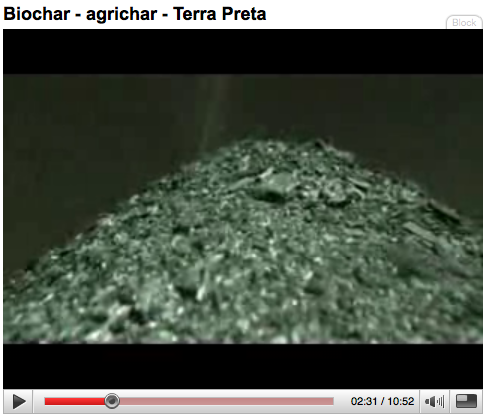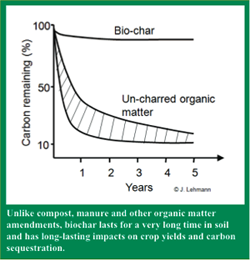We’ve lost some of our site images, but here are representative images of our process in creating biochar via pyrolysis–a form of incineration that chemically decomposes organic materials by heat in the absence of oxygen.
The process is attracting the attention of community members, soil scientists, organic gardeners, and environmental engineers, as it has been shown to be both a carbon-negative soil amendment that helps to mitigate climate change and it has the potential to dramatically increase soil fertility. These images represent our process or replicating previous community efforts; although larger-scale initiatives are underway internationally, we focus on what local gardeners and small farmers might attempt here in the Houghton and Keweenaw area.

Read the rest of this entry »
From the Boston Globe:
“Researchers trying to replicate the fertility of terra preta have concluded that its secret is in the charcoal. Work by soil scientists like Laird, Johannes Lehmann of Cornell, and Mingxin Guo of Delaware State University suggests that the benefits of supplementing soil with charcoal – which they call ‘biochar’ to distinguish it from the fuel of backyard barbecues – could be dramatic, widespread, and durable.”

“Biochar, they have found, enhances the retention of water and nutrients, decreases the need for fertilizer, encourages microbial growth, and allows more air to reach crop roots. It also breaks down at a far slower rate than traditional fertilizers and soil additives.”
Depending on how the charcoal is made and applied, estimates of its life span range from decades to millennia. Scientists believe that some Amazonian terra preta soils are at least 2,000 years old. ‘Biochar is much more effective at doing all the great things that normal organic matter usually does in soil, but it does it in much more effective ways, and it does it in a much longer way,’ says Lehmann.”
Read the rest of this entry »

In addition to the garden and small-farm applications we’ve been considering for biochar, one of the scientific appeals of biochar is its potential to help mitigate global warming by sequestering carbon that would otherwise be released into the atmosphere. A new book — Slash and Char as Alternative to Slash and Burn — discusses the science behind biochar in some detail:
Energy and agricultural systems based on biochar could help tackle four of the world’s most pressing issues all at once:
- they could allow resource poor farmers in the tropics to improve agricultural yields considerably and thus fight poverty and food insecurity;
- they can reduce global carbon emissions on a massive scale by creating a stable carbon sink: as plants take CO2 from the atmosphere, store it in their tissue and are then turned into biochar sequestered in soils, the carbon stays locked up for centuries, possibly millenia;
- they allow for the production of renewable carbon-negative bioenergy, either in the form of electricity or liquid fuels, and can thus bring energy to millions of the world’s rural households who currently lack access to modern energy;
- they could become one of the keys to slowing tropical deforestation – itself a major source of greenhouse gas emissions – by prompting millions of shifting cultivators to change their current practise of ‘slash and burn’ agriculture to ‘slash and char’ instead. Shifting cultivation is caused by the rapid depletion of soils, forcing farmers to clear forest for new land every few years; in contrast, biochar amended soils would boost soil fertility, bring the farmers higher yields, thus limiting their need to take new land into cultivation.
Read the rest of this entry »
From the Australian Broadcasting Company science show Catalyst, an 11-minute video reporting on biochar, especially current research and agricultural applications: “Their early results promise green energy, soil restoration and greenhouse mitigation from an affordable technology that can remove more CO2 from the atmosphere than is released.”
 “
“
From the Sustainable Harvest International spring 2008 Newsletter, which includes a description of a biochar project workshop in Honduras:
Research so far has shown that biochar acts as a soil conditioner, not as a fertilizer. Indeed biochar improves the efficiency of fertilizers, be they chemical  or organic. It acts as a sponge to retain applied nutrients in the rooting zone, whereas these would be flushed with water deeper into the soil without biochar. Biochar also likely improves water retention in sandy soils and likely has beneficial
or organic. It acts as a sponge to retain applied nutrients in the rooting zone, whereas these would be flushed with water deeper into the soil without biochar. Biochar also likely improves water retention in sandy soils and likely has beneficial
effects on the microbial communities in the soil.
Research has shown that when biochar was applied to soil, the emission of greenhouse gases such as nitrous oxide was reduced. This means that we can retain much-needed nitrogen in the soil for plant growth, while reducing the contributions of soils to global climate change. especially in tropical climates. So, by making biochar with biomass and applying it to soil, we can capture carbon and sequester it into the soil over extremely long time scales. Not only is carbon sequestered, but biochar added to soil progressively improves and has a better potential to increase crop yields.








 or organic. It acts as a sponge to retain applied nutrients in the rooting zone, whereas these would be flushed with water deeper into the soil without biochar. Biochar also likely improves water retention in sandy soils and likely has beneficial
or organic. It acts as a sponge to retain applied nutrients in the rooting zone, whereas these would be flushed with water deeper into the soil without biochar. Biochar also likely improves water retention in sandy soils and likely has beneficial